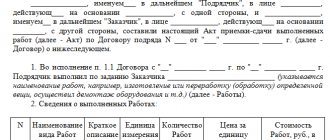As a rule, the main attention when selling an apartment on the secondary market is paid to the contract, as well as the procedure for transferring funds. It is important to draw up a coolie sale agreement correctly, otherwise it may be recognized by the court as invalid, which is grounds for cancellation of the transaction. In this case, the apartment automatically goes to the previous owner, but there may be some surprises with the money. But sometimes they simply forget about drawing up a transfer and acceptance certificate, although in some areas (for example, the Moscow region), without this document the contract will simply not be accepted for registration.
What does the law say?
First, we should consider what the law says regarding this document. The Civil Code of the Russian Federation contains Article 556 “Transfer of Real Estate”, which states that the transfer of real estate occurs exclusively under a transfer deed (or other transfer document), and the moment of signing this act is the moment of transfer of the apartment. The key emphasis should be placed on the concept of “moment of transfer” - only after this document is signed, the property is considered transferred, and the obligations of the parties under the purchase and sale agreement are considered fulfilled. Not after signing the contract and not after the actual transfer of housing, and not even after registering the transaction, but only after signing the acceptance certificate.
So, the mentioned legislative act makes it clear that without signing the act, the transaction is not complete, since the parties have not fulfilled their obligations to each other. What consequences may occur? In most cases, there are no consequences; the new owner of the apartment can live comfortably in it all his life, without ever knowing that he did not do something. However, unfortunately, this is not always the case...
How to compose it correctly?
In what form should it be?
The law does not contain any instructions regarding the form in which the act must be drawn up. There is only the word “document”, on the basis of which we can conclude that the act is prepared in writing. No mandatory forms, forms, etc. have been officially approved.
Moreover: even if the agreement itself was notarized (in accordance with the Federal Law “On State Registration of Real Estate” or at the request of the parties), there is no need to have the act certified by a notary .
According to Art. 556 of the Civil Code of the Russian Federation, the act is a separate document that only records the fulfillment by the seller of his obligations under the transaction. It does not change any of the terms of the contract itself, and therefore cannot be considered as an integral part of the transaction.
It must be remembered that the parties have the right to certify not only those documents that require a notary’s mark , but also any others.
The issue of the notarial form of the deed of acceptance and transfer is not clearly resolved in the law. Therefore, if the agreement itself was notarized, it is better for the parties to notarize the deed of transfer as well, in case Rosreestr has any questions. But this is only an additional security measure, and not a mandatory requirement.
Required information
Also, the law does not indicate what information must be included in the acceptance certificate. However, in practice it usually includes the following information:
- The name of the document (“Acceptance and Transfer Certificate”).
- Place and time of signing.
- The parties who signed the document indicating their status under the contract (who is the seller, who is the buyer). For citizens, it is better to also indicate passport data, and for organizations (if, for example, an apartment is purchased directly from a developer) - the legal form and registration data, as well as information about who signs the document and on what basis (based on the charter, power of attorney, etc.) .d.).
- Description of the apartment indicating its address or cadastral number.
- The fact of the presence or absence of claims of the parties to each other.
- Signatures of the parties.
Below you have the option of a transfer deed for a purchase and sale agreement and a sample deed of transfer of an apartment under a purchase and sale agreement.
How to correctly describe housing?
In order to protect themselves from unfounded claims, the parties must indicate in what condition the housing was transferred . At a minimum it must be indicated:
- Description of the condition in which the premises itself are located. If present, obvious defects should be noted - traces of leaks, cracked plaster, etc.
- Description of the condition of sewerage, water supply, electricity and gas supply systems (if available).
- The safety of doors and locks on them, windows and frames, the serviceability of switches and sockets.
- Description of interior items or furnishings of the apartment, if they are transferred along with the housing.
It is highly advisable to also indicate meter readings in the act. This will help avoid disputes about the presence or absence of utility debts in the future.
Video about the intricacies of the transfer deed:
Acceptance and transfer of an apartment: five tips
Unpleasant consequences for the seller
The fact is that, in addition to failure to fulfill obligations (which until now sounded like some kind of theoretical abstraction), the buyer, according to the law, cannot assume obligations regarding the maintenance and servicing of the apartment, and also cannot bear the risks of its accidental damage and death. All of the above risks continue to be borne by the seller. To illustrate this point, let us give the following example: a year after the purchase (the transfer and acceptance certificate was never signed), the apartment was severely damaged by a fire.
Firstly, since the real estate was not officially transferred, the new owner can go to court, claiming that the former owner transferred the apartment to him in a condition that was not specified in the contract (he promised, they say, to sell the whole apartment, but now it is burnt down ) or did not transmit anything at all. Secondly, if neighbors were injured in a fire, they will be forced to file claims for the restoration of property. And, since there is no transfer and acceptance certificate, then all risks continue to be borne by the previous owner. That is, the neighbors’ claims, according to logic, should be addressed to him. In practice, of course, this cannot happen; a trial will arise, and the court will be on the side of the former owner of the apartment, but he will most likely not be happy with the possibility of opening a trial.
When is it compiled?
This document is not legally independent, but only an annex to the main agreement. The act is signed by both the buyer and the seller after drawing up the contract or on the same day or on any other day as agreed by the parties to the transaction.
A document confirming acceptance of a share in the apartment can be drawn up before or after drawing up a receipt for receipt of money.
It is also possible to have the document drawn up by a notary certified, but there are no official legal requirements in this regard. That is, the parties to the transaction must decide whether to certify or not.
Example. Brother and sister Shubin inherited a one-room apartment after their father’s death. Everyone got ½ share.
The relatives agreed that Shubin would sell his share to his sister. They assessed the value of his part of the home and drew up a purchase and sale agreement.
On the same day, the money was transferred, a receipt was drawn up about this, and half of the apartment was inspected and accepted according to the transfer certificate. After this, Shubina contacted Rosreestr and after 14 days received an extract from the Unified State Register of Real Estate stating that she is the sole owner of the apartment.
Unpleasant consequences for the buyer
Drawing up and signing a transfer and acceptance certificate is especially important for the buyer when it comes to purchasing an apartment in a newly built building. So, in addition to handing over the keys to the apartment, no less important is the moment when it is time to record the complete fulfillment of the developer’s obligations to the client. The only tool that allows you to do this is precisely the act of acceptance and transfer of the apartment.
Yes, the construction company built the house and put it into operation, but how well was the work carried out? Practice shows that when inspecting a new home, the developer’s clients are sometimes not very happy with the way the finishing is done, how the utilities work, and also notice other shortcomings. While the contract (if we take into account the standard shared participation agreement, which stipulates that the work must be performed not only taking into account accepted building codes and regulations, but also be of adequate quality) excludes the possibility of such shortcomings. That is, it turns out that the developer did not fully fulfill his obligations.
Common Mistakes
When filling out the act, the following mistakes are most often made:
- When indicating the cost of goods, VAT is not included. When completing a transaction, the parties must agree "onshore" as to what tax scheme they are both operating under and whether they are operating with or without VAT. It happens that a partnership breaks down due to different methods of paying taxes.
- Signing before the actual reception. Sometimes the recipient is in such a hurry that he signs this document before the furniture is fully assembled or inspected and tested. Defects can be detected either immediately or over time. When signing the acceptance certificate, the main thing is to be extremely focused on checking the quality and quantity of the goods provided.
In accordance with the third paragraph of Article 455 of the Civil Code of the Russian Federation, as well as its 506th article, the essential conditions of delivery are met, if only the recipient has signed the acceptance certificates. And the essential conditions, according to the law, are the name, quantity and cost of the goods. That is, everything that was specified in the main part of the act.
To sign or not?
Some happy owners of new apartments turn a blind eye to various shortcomings due to the fact that they consider such phenomena to be a common practice; a number of shortcomings can actually be tolerated, since they are insignificant, and some citizens are still going to do a major overhaul, which includes redevelopment to the tastes of the new owner. The deed is simply signed, and based on its signing (and the agreement), the shareholder issues a certificate of title to the property. However, what should you do if there are serious shortcomings, the correction of which at your own expense can cost a pretty penny?
It would be logical to assume that since the developer began to build a house, promising the proper quality of apartments, then it is he who must correct everything that does not correspond to the concept of “proper quality.” That’s right, the developer must fix everything, as quickly as possible and at his own expense. To achieve this, you need to wait until the very moment comes when a representative of the developer arrives to sign the deed. If the client does not agree to fix everything himself, waste time and waste money, it is necessary to indicate the identified defects in the inspection sheet and refuse to sign the acceptance certificate (until the listed defects are eliminated).
However, the inspection report with a list of identified deficiencies must also be signed by the developer - in fact, the developer’s signature means his agreement with the presence of defects, which automatically leads to an obligation to eliminate them. But the developer is usually in no hurry to sign this document, since correcting the defect may lead to additional costs, which can be very significant, especially if the owners of other apartments do the same.
How is the condition of the apartment or its share described?
A description of the current state of the property can be presented in any format (text, table or list). The only important condition is an exhaustive reflection of the real facts that were obtained during the inspection of the residential premises and inspection of various communication systems.
Thus, special attention should be paid to:
- bathroom, plumbing in the kitchen and bathroom, electrical wiring;
- serviceability of the landline telephone;
- the general condition of the apartment and its components (entrance and interior doors, window and door openings, walls, ceiling, floor, decorative elements, etc.);
- the quality of the property located in the apartment and becoming the property of the new owner after alienation (built-in shelves, cabinets, sofas, household appliances, etc.).
It is necessary that in the text of the transfer act only technical characteristics are given and only clear value judgments are used . For example:
- “Excellent condition” - the object or system is in good condition and has no obvious or hidden defects.
- “Good condition” - an object or system has minor deficiencies that do not interfere with its normal functioning.
- “Satisfactory condition” - the object or system is in working condition, but has significant defects. For example, in an apartment that is jointly owned by several co-owners, there may be problems with the water supply (uneven pressure, long wait times for heating, etc.).
If the apartment has objective defects that are recognized as such by both the Seller and the Buyer, they must also be described in the immediate text of the document (“malfunction of the kitchen hood”, “presence of numerous chips and cracks on the tiles in the bathroom”, etc.).
The Buyer has the right to learn about all the shortcomings of the alienated property before signing the transfer deed and the final transfer of ownership. It is the Buyer’s responsibility , in its own interests, to take all possible measures to detect such defects.
What to do if the developer refuses to sign the deed?
The developer’s avoidance of signing the acceptance certificate can, in principle, relieve him of the need to correct any defects (and incur costs for this). According to the law, if the shareholder does not sign the deed within two months, the developer can sign the document on his part, and his obligations will thus be considered fulfilled. Therefore, if defects are discovered during an inspection of a new apartment, it is not enough to simply refuse to sign the act, just as it is not enough to provide a written argument for this refusal with a list of defects included in the inspection sheet.
The shareholder needs to sign the inspection sheet on his part and send a formal claim to the developer, demanding that the necessary corrections be made. After waiting a certain period, you need to go to court with a corresponding application.
Punishment for evading signing the act
However, evasion from signing the transfer acceptance certificate (both on the part of the seller and the buyer) is also considered by the Civil Code, which provides for penalties in this case. In the case of apartments in new buildings, the clause on the procedure and terms for transferring the apartment according to the deed must be indicated in the contract, and in the case of selling real estate on the secondary market, there may be no talk about signing the deed, only the date of transfer of property is indicated, but this is precisely the procedure required by law.
Since the transfer deadlines are specified in the contract, violation of these deadlines by the developer entails the application of penalties (which may not be specified in the contract, but are quite clearly defined by law). The amount of the fine is one three hundredth of the Central Bank refinancing rate (the current figure is taken as a basis) of the contract price. Thus, if an apartment costs about 3 million rubles, and the Central Bank rate is, for example, 15%, then the seller of the apartment (developer) is obliged to pay 4,500 rubles per day for each day of delay in the transfer of real estate (and the transfer of the apartment, as we remember , occurs precisely at the moment of signing the act).
Deed of acceptance and transfer of apartment share sample 2021 free download standard form example form
ACT OF ACCEPTANCE AND TRANSFER
to the Agreement for the purchase and sale of a share of an apartment from ____________
Moscow "___" __________ 20__
________________________________________________________,
____________ year of birth, place of birth: ________________, citizenship: Russian, gender _____________, passport ______________________, department code ___________, registration and residence address: _________________, hereinafter referred to as the
“Seller”
, and
________________________________________________________,
____________ year of birth, place of birth: ________________, citizenship: Russian, gender _____________, passport ______________________, division code ___________, registration and place of residence: _________________, hereinafter referred to as the “
Buyer
”, on the other hand, collectively referred to as the “Parties”, have entered into this Act on the following:
- The Seller transferred into ownership (SOLD), and the Buyer accepted into ownership (BUYED), the Seller's right of ownership ______ share of the apartment
, with a total area excluding the area of loggias, balconies, verandas, terraces __________________ sq. m.
meters, including living area _____________________ sq.m., the area of the apartment taking into account the area of loggias, balconies, verandas, terraces amounted to _________________ sq.m. The apartment is located on the ______________ floor of a ________________-storey brick/panel building at the address : Moscow, st.
___________, house ________, building ________ apartment _________. Upon signing this agreement, the Seller transferred ownership, and the Buyer accepted ownership of the apartment and the right of ownership to a share in the common areas of the specified residential building. - At the time of signing this Transfer and Acceptance Certificate, the Buyer has no complaints about the quality of the apartment.
- The Seller also handed over, and the Buyer accepted, a set of title documents for the apartment, documents on the technical condition of the apartment, as well as the apartment.
- The risk of accidental death or accidental damage to the apartment passes to the Buyer from the moment of signing this Act.
- This Transfer and Acceptance Certificate is drawn up in three copies having equal legal force, one for each of the Parties, one for the registering authority.
SIGNATURES OF THE PARTIES
Example No. 2
TRANSFER ACT
City of Moscow ___________________________ two thousand ________________
We, gr. Russian Federation ___________________________________________, __ _________ 19__ year of birth, passport of a citizen of the Russian Federation __ __ _________, issued by the PASSPORT OFFICE No. _ Department of Internal Affairs ________________________ Department of Internal Affairs ____ CITY OF MOSCOW, __ ________ 200_, department code _________, registered at the address: city _________, street _________________ house _, apartment ___, hereinafter referred to as the “Seller”, on the one hand,
and gr. Russian Federation _________________________, __ __________ born in 19__, passport of a citizen of the Russian Federation __ __ _________, issued by the DISTRICT DEPARTMENT ________________ OFMS OF RUSSIA IN THE CITY ___________________ __ __________ 200_, division code ________________, registered at the address: city __________, street ______________ house __, apartment ___, hereinafter referred to as “Buyer”, on the other hand, in accordance with Art.
556 of the Civil Code of the Russian Federation, have drawn up this Transfer Deed as follows:
The “Seller”, in accordance with the purchase and sale agreement dated __ _________ 200_, sold to the “Buyer” 1/2 (one second) share in the right of common shared ownership of the apartment located at the address: CITY ________, ____________ STREET, BUILDING __, Bldg. . __, apartment No. __, conditional number: ______________.
The specified apartment consists of _____________ living rooms, has a total area of _________ (______________________) sq.m., including a living area of ____ (______________________) sq.m.
Expert opinion
Romanov Igor Severinovich
Lawyer with 7 years of experience. Specialization: civil law. Extensive experience in developing legal documentation.
According to this act, the “Seller” transferred to the “Buyer” the above-mentioned real estate in good condition, as it is on the day of signing this act.
The apartment was handed over in a condition suitable for habitation, unencumbered by debt on utility bills, tax payments, and electricity bills.
The “Buyer” accepted from the “Seller” the above-mentioned real estate in the form in which it is on the day of signing this act, and paid the “Seller” the cost of the transferred real estate in full.
By this act, each of the parties to the agreement confirms that the obligations of the parties have been fulfilled, the payment has been made in full, and the parties have no claims against each other regarding the substance of the agreement.
This deed of transfer has been drawn up and signed in three copies having equal legal force, one for each of the parties, the third for storage in the files of the Federal Registration Service for the city of Moscow.
For any method of transferring a share in residential real estate (purchase and sale, exchange, gift), in addition to the main agreement, it is necessary to draw up an annex to it - an act of acceptance of the transfer. You will learn how to do this, what nuances there are and when this document needs to be signed in our article.
Difficulties in filing tax deductions
It is also necessary to mention that a buyer who did not ensure that the transfer and acceptance certificate was signed may have real complications with the registration of a tax deduction. If housing was purchased from a developer under an equity participation agreement, then, as we understand, the existence of such an act is determined by the order of relations between the developer and the shareholder. If housing is purchased on the secondary market, then this act, in principle, is not required, but the tax service will require a certificate of registration of property rights, and in order to obtain this document in a number of regions, the presence of a transfer act is a prerequisite.
Is it necessary and why?
As for whether this document is mandatory, first of all it must be said: the legislation regulating issues of purchase and sale does not provide for the mandatory drawing up of a transfer deed in all cases.
Art. Art. 456-458 of the Civil Code of the Russian Federation, which establish general norms for transfer during purchase and sale, only say that the seller is obliged to transfer the goods to the buyer .
Specifically for real estate, the transfer deed is already provided for in Art. 556 of the same code, but this article only indicates the signing by the parties of a document recording the moment of fulfillment of the obligation. As a result, another document may be used instead of the act.
Nevertheless, in legal relations that arise when purchasing an apartment, it is the act of acceptance and transfer that is most convenient . This document serves as a tool through which the parties:
- state that the obligation to transfer the housing by the seller has been fulfilled;
- indicate the condition in which the apartment was transferred (this is important in case disputes arise in the future about the quality of the housing and whether it had obvious defects and shortcomings, and is especially important if the property is purchased on the secondary market).
The latter is especially important. Part 2 art. 556 of the Civil Code of the Russian Federation indicates that even if the buyer agreed to accept real estate that has defects, this does not relieve the seller from liability. And in this case, during further proceedings, it is the act indicating the defects that will be one of the pieces of evidence in court.
The transfer is not limited to signing the deed. The law requires that housing be physically transferred - at least by handing over the keys to it. If the deed is signed, but the seller actually prevents the use of the apartment, this is a reason to go to court.
Let's watch a video about what an apartment transfer and acceptance certificate is and why it is needed:
Apartment acceptance certificate
Complications during the sale
The absence of a transfer and acceptance certificate can lead to certain complications during the sale of an apartment. Let’s say that a potential buyer has been found, but he wants to take out a mortgage loan to purchase an apartment. In turn, some banks, in addition to the certificate of ownership, want to see an act according to which the living space was transferred to the current owner. This requirement is caused by the desire to exclude any possibility of the property, which is collateral, being released from the bank’s encumbrance (the risk of losing the collateral).
Thus, the seller loses part of the audience of potential buyers who would like to buy his apartment with a mortgage. This implies the need for the seller to reduce the price if he wants to sell the property quickly or increases the time frame for selling the property.
What should be the transfer and acceptance certificate?
The legislation does not contain a description of the form of the act of acceptance and transfer of an apartment; the only guidance for the seller and buyer in drawing up such an act is judicial practice. The document must reflect the following information:
— Date of signing and place; — Description of the property being transferred; — Cadastral data (address, area); — Condition of the apartment (reflected in the inspection report); — Additionally, photographs may be attached; — Details of the agreement (to which the act is attached); — Data of the parties (personal data, addresses); - Signatures of the parties.









